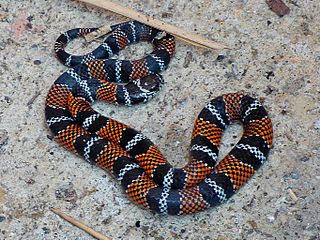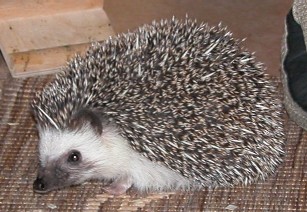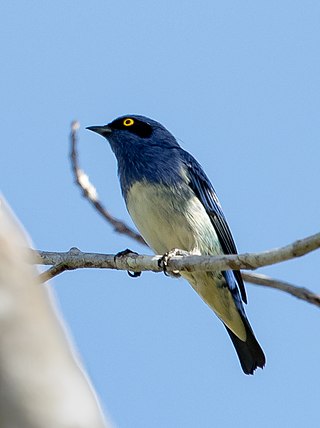
The lesser bulldog bat is an insectivorous and occasionally carnivorous bat of the (Neotropics), ranging through Central America and northern South America. Some unique characteristics of the bat include, large feet that are used to rake the surface of water to capture prey, and precise echolocation. Occasionally, the larger bats catch and consume small fish.
Erythrolamprus ocellatus, commonly known as the Tobago false coral snake, Red snake, or Doctor snake is a species of colubrid snake, which is endemic to the island of Tobago.

Erythrolamprus bizona, commonly known as the double-banded false coral snake, is a species of colubrid snake, which is endemic to northern South America and Central America.

Erythrolamprus aesculapii, also known commonly as the Aesculapian false coral snake, the South American false coral snake, and in Portuguese as bacorá, or falsa-coral, is a species of mildly venomous snake in the family Colubridae. The species is endemic to South America.
False coral may refer to many species of snakes, including:

The four-toed hedgehog, is a species of hedgehog found throughout much of central and eastern Africa.

The white-eared opossum, known as the timbu in Brazil and comadreja overa in Argentina, is an opossum species found in Argentina, Bolivia, Brazil, Paraguay, and Uruguay. It is a terrestrial and, sometimes, arboreal animal, and a habitat generalist, living in a wide range of different habitats.

James Ray Dixon was professor emeritus and curator emeritus of amphibians and reptiles at the Texas Cooperative Wildlife Collection at Texas A&M University. He lived in El Campo, Texas throughout most of his childhood. He published prolifically on the subject of herpetology in his distinguished career, authoring and co-authoring several books, book chapters, and numerous peer reviewed notes and articles, describing two new genera, and many new species, earning him a reputation as one of the most prominent herpetologists of his generation. His main research focus was morphology based systematics of amphibians and reptiles worldwide with emphasis on Texas, US, Mexico, Central America, and South America, although bibliographies, conservation, ecology, life history and zoogeography have all been the subjects of his extensive publications.

Erythrolamprus is a genus of colubrid snakes, commonly known as false coral snakes, native to Central America, the Caribbean, and the northern part of South America. They appear to be coral snake mimics.

The brown-hooded kingfisher is a species of bird in the subfamily Halcyoninae, the tree kingfishers. It has a brown head and blackish and turquoise wings. It is found in Sub-Saharan Africa, living in woodland, scrubland, forest edges, and also suburban areas. The International Union for Conservation of Nature (IUCN) has assessed it as being of least concern.

The white-bellied dacnis is a species of bird in the family Thraupidae. It is found in Brazil, Colombia, Ecuador, Peru, and Venezuela. Its natural habitat is subtropical or tropical moist lowland forests.

The Samoan flycatcher is a species of bird in the family Monarchidae. It is endemic to Samoa. Its natural habitats are subtropical or tropical moist lowland forests, subtropical or tropical moist montane forests, and rural gardens and is threatened by habitat loss.

The green-backed whistler or olive-backed whistler, is a species of bird in the family Pachycephalidae. It is endemic to the Philippines.

Trochocercus is a genus of bird in the family Monarchidae. Described by Jean Cabanis in 1850, the name Trochocercus is a combination of the Greek words trokhos meaning "circular" or "round" and kerkos, meaning "tail".
Erythrolamprus ornatus, also known commonly as the ornate ground snake and the Saint Lucia racer, is a species of snake in the family Colubridae. The species is native to the eastern Caribbean. It is the rarest snake on earth with fewer than 20 left in the wild.
The Barbados racer, also commonly known as the tan ground snake, was a species of colubrid snake that was endemic to Barbados. It is now extinct.

Atelerix is a genus of hedgehog in the family Erinaceidae. It contains four species, all native to Africa.

The white-bellied blue robin or white-bellied sholakili, is a bird of the family Muscicapidae. It is endemic to the Shola forests of the higher hills of southern India. The Nilgiri blue robin and this species were once considered separate species, later lumped as sub-species of a single species (major) and elevated again to full species in 2005 by Pamela C. Rasmussen. The species was earlier thought to be related to the shortwings and placed in the genus Brachypteryx and later moved to Myiomela since species in the genus Brachypteryx shows marked sexual dimorphism. In 2017, a study found that this is a sister group of the flycatchers in the genera Niltava, Cyornis and Eumyias among others. It was then placed in newly erected genus Sholicola. This small bird is found on the forest floor and undergrowth of dense forest patches sheltered in the valleys of montane grassland, a restricted and threatened habitat.

The military ground snake is a species of snake in the family Colubridae. The species is endemic to South America.














